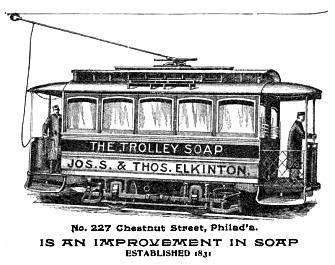A long page grew out of this much shorter post. The Web page on this site is called “Navigation.” This post could have a fancier title; for example, “How Transportation Transforms Our View of Geography.” We know that the way we travel shapes our ideas of location and distance. One example is this joke: “You’re from New Jersey? Which exit?” A second would be the tie between Sugar Hill and the “A” train; we evade the landscape by zipping along under or above it, so that a destination is the place on the route where we return to the landscape. A third comes from an imaginary but typical conversation with a friend who lives in the Greater Northeast. The friend has found a fabulous new diner or thrift store. “But how far away is it?” “Two buses.”
In the middle of the nineteenth century, the spread of urban public transportation with fixed routes and schedules provided a new, if supplementary, way of giving locations. In 1867, when a new version of Edwin T. Freedley’s Philadelphia and Its Manufactures (with advertisements!) appeared, the hundreds of omnibus cars of the late 1850s had been replaced with street cars―still drawn by horses, but drawn more smoothly and quickly along a rail. Some of Freedley’s advertisements give, in addition to street addresses, directions that are also standardized, because they are based on passenger car routes. Customers are advised to take a public street car to a factory that makes elegant private carriages. That seems ironic, like using a computer to buy a manual typewriter, though it probably reflects enduring class distinctions as well as the difference between pleasure and display, and the need to get from one place to another.
Some companies advertised their street-car connections visually rather than in words. They show, not a generic bustling street scene, but the very line that passed the company.
The Trolley Soap advertisement (from The Reporter’s Nosegay, 1896) jumps ahead into the last years of the century, but I could not resist it.
Navigation Continued: “Marks and Numbers of Streets,” from the Philadelphia PUBLIC LEDGER, 1836
















I like the idea of giving directions by the number of buses (It takes two buses) rather than, in the case of LA, You take the 405 to the 10 (freeway). I happen to love public transportation so I am inclined to tell people how many buses and trains it takes to arrive at the destination!
LikeLike
Around 1966 I tried to get from Granada Hills to downtown Hollywood, on my own and by public transit. I wish I could remember how many buses, and hours, that took!
LikeLike
I love public transit, even after growing up in Southern California when we were lucky to see a bus now and then. It’s just that this is a new way of seeing the world. We see an older one in the comment of the sister of Dorothea in Middlemarch, who is cannot understand why her sister will marry a poor (but dashing!) young man and live on a street. Where else would she live–is she a mermaid or a sprite? Well, of course, in a proper world she would live on an estate too grand and well known to have a street address. That the sister prefers a dull estate to London seems perverse. Three cheers for streets, grids, and streetcars! Somehow it seems I have sung this song before, but it is worth singing.
LikeLiked by 1 person
Just read this. Middlemarch keeps coming up in conversation. I never read the book but now I have to at least see the TV production so I know what people are talking about!
LikeLike
I think you will like it: intelligent adaptation, sympathetic heroine, most attractive leading man!
LikeLike
I enjoyed reading yyour post
LikeLike